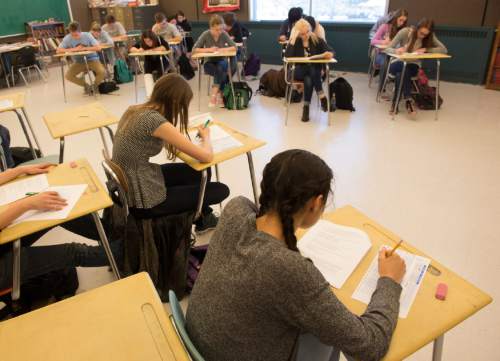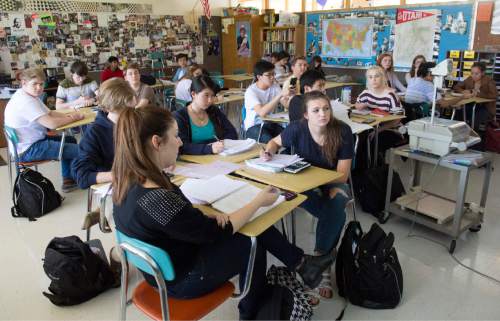This is an archived article that was published on sltrib.com in 2016, and information in the article may be outdated. It is provided only for personal research purposes and may not be reprinted.
A statewide property tax increase approved by Utah lawmakers last year paid for teacher salary increases, smaller class sizes, additional school staff and building maintenance.
That's according to a survey, presented to lawmakers on Wednesday, of the 28 school districts that received a combined $50 million from Utah taxpayers.
And roughly $24 million remains to be distributed to schools due to a clerical error in the law, SB97, which aimed to better equalize education funding in the state by creating a per-pupil revenue floor for property taxes.
"We tax the wealth where it exists to teach the students where they exist," said state Sen. Howard Stephenson, R-Draper.
Stephenson, president of the Utah Taxpayers Association, is a frequent proponent of funding equalization, pointing to disparities that lead to school districts with lower property values collecting less revenue despite levying proportionately higher taxes on homeowners.
Under SB97, every homeowner in the state saw a tax increase, but the $75 million collected was distributed only to school districts that fell below a set funding threshold.
By adding $25 million each year to the equalization formula, Stephenson said, Utah could achieve a relative equilibrium in school funding in five to seven years.
"We will never achieve Park City [funding levels]," he said. "They're just in the stratosphere as far as funding goes."
Park City School District is among 13, including Salt Lake City School District, Canyons School District and Murray School District, that did not collect additional funding despite residents in those areas paying higher taxes.
Utah's largest school districts, Alpine and Davis, received roughly $11 million and $9 million, respectively, according to a legislative report.
State Sen. Lyle Hillyard, R-Logan, said there is a need to ensure that new revenues are spent appropriately as equalization efforts continue.
Hillyard represents voters in both Logan School District and Cache County School District, and he said property tax rates and school funding play into where Cache Valley residents decide to live.
After the equalization bill took effect, Logan received $450,000, with no money for capital projects, compared to more than $2 million distributed to Cache County.
"People in Logan had a property tax increase to [equalize school funding], but the money all went elsewhere," he said.
And state Rep. Marie Poulson, D-Salt Lake City, suggested that equalization at the state level, determined by lawmakers, bypasses the ability of voters to accept or reject the taxing efforts of local school boards.
"They like that their taxes go to their district and they can have some accountability for how that money is spent," she said.
bwood@sltrib.com Twitter: @bjaminwood







